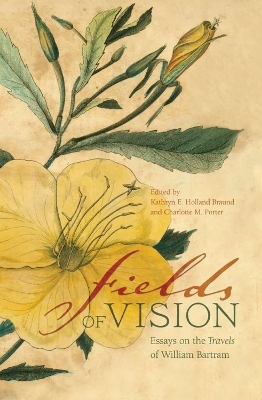
Fields of Vision
Essays on the Travels of William Bartram, 1739-1823
2010
The University of Alabama Press (Verlag)
978-0-8173-5571-5 (ISBN)
The University of Alabama Press (Verlag)
978-0-8173-5571-5 (ISBN)
- Titel z.Zt. nicht lieferbar
- Versandkostenfrei
- Auch auf Rechnung
- Artikel merken
William Bartram portrayed nature through the lens of experience as well as scientific observation. 'The Bartram Trail Conference' fosters Bartram scholarship through biennial conferences held along the route of his travels. This volume of essays, a selection from conferences, brings together contributions from history, archaeology, and botany.
William Bartram was a naturalist, an artist, and the author of ""Travels through North and South Carolina"", ""Georgia"", ""East and West Florida"", ""The Cherokee Country"", the ""Extensive Territories of the Muscogulees, or Creek Confederacy"", and the ""Country of the Choctaws"". The book, based on his journey across the South, reflects a remarkable coming of age. In 1773, Bartram - a British colonist - departed his family home near Philadelphia, Pennsylvania; in 1777, he returned as a citizen of an emerging nation, the United States. The account of his journey, published in 1791, established a national benchmark for nature writing and remains a classic of American literature, scientific writing, and history. Brought up as a Quaker, Bartram portrayed nature through a poetic lens of experience as well as scientific observation, and his work provides a window on 18th-century southern landscapes. Particularly enlightening and appealing are Bartram's detailed accounts of Seminole, Creek, and Cherokee peoples. ""The Bartram Trail Conference"" fosters Bartram scholarship through biennial conferences held along the route of his travels. This richly illustrated volume of essays, a selection from recent conferences, brings together scholarly contributions from history, archaeology, and botany. The authors discuss the political and personal context of his travels; species of interest to Bartram; Creek architecture; foodways in the 18th-century south, particularly those of Indian groups that Bartram encountered; rediscovery of a lost Bartram manuscript; new techniques for charting Bartram's trail and imaging his collections; and Bartram's place in contemporary environmental issues.
William Bartram was a naturalist, an artist, and the author of ""Travels through North and South Carolina"", ""Georgia"", ""East and West Florida"", ""The Cherokee Country"", the ""Extensive Territories of the Muscogulees, or Creek Confederacy"", and the ""Country of the Choctaws"". The book, based on his journey across the South, reflects a remarkable coming of age. In 1773, Bartram - a British colonist - departed his family home near Philadelphia, Pennsylvania; in 1777, he returned as a citizen of an emerging nation, the United States. The account of his journey, published in 1791, established a national benchmark for nature writing and remains a classic of American literature, scientific writing, and history. Brought up as a Quaker, Bartram portrayed nature through a poetic lens of experience as well as scientific observation, and his work provides a window on 18th-century southern landscapes. Particularly enlightening and appealing are Bartram's detailed accounts of Seminole, Creek, and Cherokee peoples. ""The Bartram Trail Conference"" fosters Bartram scholarship through biennial conferences held along the route of his travels. This richly illustrated volume of essays, a selection from recent conferences, brings together scholarly contributions from history, archaeology, and botany. The authors discuss the political and personal context of his travels; species of interest to Bartram; Creek architecture; foodways in the 18th-century south, particularly those of Indian groups that Bartram encountered; rediscovery of a lost Bartram manuscript; new techniques for charting Bartram's trail and imaging his collections; and Bartram's place in contemporary environmental issues.
Kathryn E. Holland Braund is Professor of History at Auburn University and editor of Bernard Romans's A Concise Natural History of East and West Florida and James Adair's The History of the American Indians. Charlotte M. Porter is Curator of the Florida Museum of Natural History at the University of Florida and author of The Eagle's Nest: Natural History and American Ideas and William Bartram's Florida: A Naturalist's Vision.
| Erscheint lt. Verlag | 28.2.2010 |
|---|---|
| Zusatzinfo | 26 illustrations |
| Verlagsort | Alabama |
| Sprache | englisch |
| Maße | 154 x 231 mm |
| Gewicht | 430 g |
| Themenwelt | Sachbuch/Ratgeber ► Natur / Technik ► Natur / Ökologie |
| Reisen ► Reiseberichte ► Nord- / Mittelamerika | |
| Geschichte ► Allgemeine Geschichte ► Neuzeit (bis 1918) | |
| Geisteswissenschaften ► Geschichte ► Regional- / Ländergeschichte | |
| ISBN-10 | 0-8173-5571-5 / 0817355715 |
| ISBN-13 | 978-0-8173-5571-5 / 9780817355715 |
| Zustand | Neuware |
| Haben Sie eine Frage zum Produkt? |
Mehr entdecken
aus dem Bereich
aus dem Bereich
Europa 1848/49 und der Kampf für eine neue Welt
Buch | Hardcover (2023)
DVA (Verlag)
CHF 67,20
Giordano Bruno - ein ketzerisches Leben
Buch | Hardcover (2024)
C.H.Beck (Verlag)
CHF 41,85


